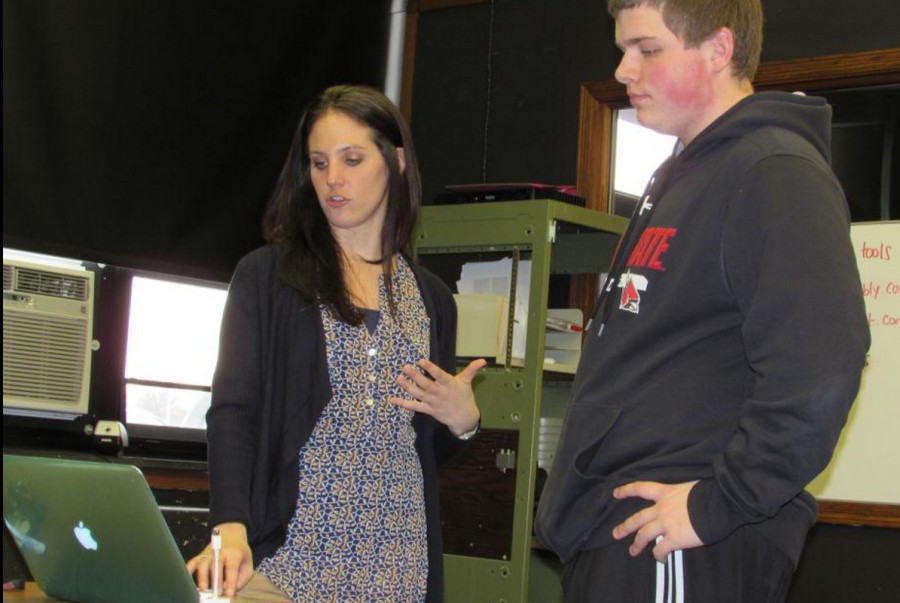Photo courtesy of Kristen DiGiorgio
Kristen DiGiorgio works with senior John Gordon in her journalism class at Bradley-Bourbonnais Community High School. The first-year adviser recently won an award of $1,000 from the 1 For All First Amendment Challenge for her innovative instructional unit on media law and ethics.
Innovation pays off for first-year adviser Kristen DiGiorgio
The Bradley-Bourbonnais teacher was one of 40 national winners in the 1 For All First Amendment Challenge, which recognized original and inventive approaches to teaching the five foundational freedoms of American democracy
May 27, 2015
BRADLEY — Creating multimedia stories, building interactive timelines or producing videos with plenty of b-roll aren’t the traditional ways in which high school journalism students demonstrate their knowledge of media law.
But for teacher Kristen DiGiorgio of Bradley-Bourbonnais Community High School, going beyond the traditional was precisely the point when she recently revised her First Amendment lesson plans.
She wanted her students to show they understood the fundamental rights and responsibilities of the press — but she wanted them to do so in a way that actively engaged their talents as digital storytellers.
The result was an innovative approach that last week earned DiGiorgio a $1,000 award as one of 40 national winners in the 1 For All First Amendment Challenge.
DiGiorgio, an IJEA member, was the only winner from Illinois.
The First Amendment Challenge honors secondary school educators for developing original and creative ways of teaching the foundational freedoms of speech, press, religion, assembly and petition.
For the complete text of DiGiorgio’s winning instructional unit, click here.
THE MOTIVATION
The first-year journalism adviser, who also teaches English, was inspired to enter the competition by her desire to improve how she taught media law and ethics.
Her initial foray into the subject earlier in the school year had proved unsatisfying to her — and, she suspected, to her students as well.
“I originally taught this unit first semester,” DiGiorgio recalled. “As teachers, we naturally personalize how our lessons go, and I just couldn’t shake off the fact that I felt I was doing a terrible job. Yes, they were learning. Yes, they were discussing concepts related to law and ethics, but it was so cut and dry.”
So when she heard about the First Amendment Challenge during Scholastic Journalism Week in February, she realized she could use the competition as an opportunity to create something truly engaging for her students.
“They know how to use multimedia, they know how to tell stories, and some of them know how to edit videos,” she said. “They are so much more capable than a test.”
THE INNOVATION
As DiGiorgio revised her lesson plans, the unit’s learning objectives didn’t change. Students would still be expected to define key terms in media law, understand the substance and significance of landmark court decisions, and apply ethical principles to a variety of challenging scenarios.
But the process by which students would demonstrate their mastery of the subject did change. Instead of taking a test, they would complete a First Amendment project using the tools of multimedia storytelling.
Like many journalism teachers, DiGiorgio has both beginning and advanced students in the same class period. So she devised options suitable for different journalistic skill levels
“For some, that means creating intricate videos, while for others that means an attempt at a video blog or creating a multimedia timeline,” she said.
APPLYING THE OPTIONS
But regardless of their skill level, all the students would be expected to show the First Amendment’s relevance to scholastic journalism.
For example, beginning students might produce a video blog in which they discuss the story of Mary Beth Tinker and how the 1969 U.S. Supreme Court ruling in her case, Tinker v. Des Moines, is still relevant to publication staffs almost half a century later.
Or they might use a multimedia app such as Steller, Storehouse or TimelineJS to illustrate the importance of First Amendment rights to scholastic journalists who have faced and overcome the threat of censorship.
More advanced students might create two-minute videos incorporating multiple interviewees and ample b-roll to tell a First Amendment story.
DiGiorgio herself had been introduced to many of these multimedia apps and storytelling platforms last summer when she attended the Reynolds High School Journalism Institute for advisers.
By applying these tools to her law and ethics unit, she could enable her students to combine their media talents with their newly acquired knowledge of an essential subject area.
“I didn’t want the project to feel like something separate from everything we have already done,” she said, “so this is a nice way to show an accumulation of their skills while simultaneously advocating their First Amendment Rights.”
A complete list of the 1 For All Challenge winners can be found here.
The American Society of News Editors’ Youth Journalism Initiative administered the First Amendment Challenge, with funding from the Robert R. McCormick Foundation. The Journalism Education Association endorsed the Challenge.
